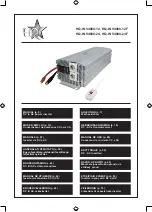
Using Audio
110
Connecting Your Audio Mixer Control Surface
Step 1.
Connect your compatible MIDI control surface to your Mac or PC. Most modern control surfaces
use USB.
Step 2.
Verify your control surface is recognized by your computer as a MIDI device.
For Mac OS X computers, go to Applications/Utilities/Audio MIDI Setup and launch the
application. Go to the Window menu and choose Show MIDI Window. Ensure your control
surface appears as a MIDI device in this window.
For Windows computers, go to Computer/Properties/Device Manager/Sound, Video and Game
Controllers and ensure your control surface appears in the list of icons.
Step 3.
The ATEM audio mixer is designed to communicate with your control surface using Mackie
Control commands so your control surface will need to support Mackie Control. You'll also need
to make sure your control surface is configured to use native Mackie Control or Mackie Control
emulation. Please refer to your control surface’s user manual for configuration details.
Some control surfaces offer several types of Mackie Control emulation and you should choose the
one that activates the most features on your control surface. For example, with the Behringer BCF
2000, choosing “Mackie Control Mapping for Cakewalk Sonar 3 [MCSo]” enables level faders,
bank selectors, balance control, AFV and ON/MUTE functions, and also activates the LED screen
which displays which bank of faders you have selected for your audio mix. The LED screen will not
activate if you choose another Mackie Control emulation.
Step 4.
Launch ATEM Software Control and it will automatically look for your control surface using the
first port on the first MIDI device that it finds. Click on the Audio tab in ATEM Software Control to
display the ATEM audio mixer. Try sliding the gain faders up and down on your hardware control
surface and verify that the audio mixer faders show a corresponding increase and decrease in the
software on your computer screen. If so, you have successfully configured your control surface to
work with the ATEM switcher.
The MUTE button
In the ATEM audio mixer interface, audio is always on, or present in the mix, when the ON checkbox is
selected. When the ON checkbox is deselected, audio is not present or is muted. To match the software
interface, you'll find the MUTE button on your audio mixer control surface will be lit when audio is always on
or present in the mix. The MUTE button will be unlit when audio is not present or is muted.
Decibel Scales
All hardware audio mixer control surfaces are made differently, and therefore the scale printed on your
control surface may not match the scale in the ATEM audio mixer interface. Always refer to the ATEM audio
mixer levels for the true decibel scales.
Step 4: Try sliding the gain faders up and down on your
hardware control surface and verify that the audio mixer faders
show a corresponding increase and decrease in the software
on your computer screen.
















































